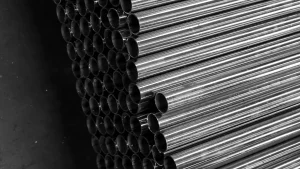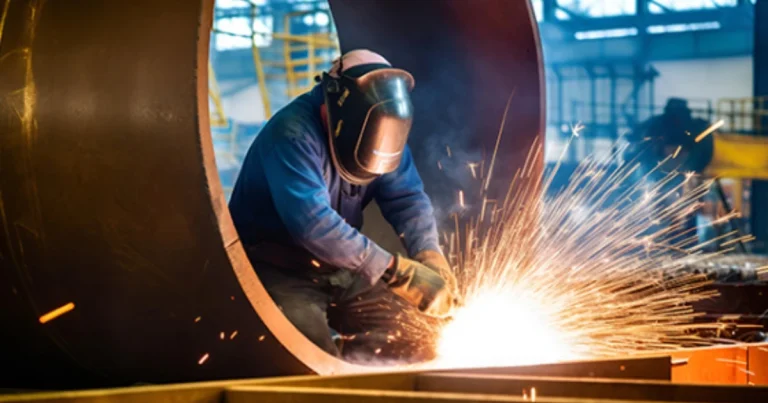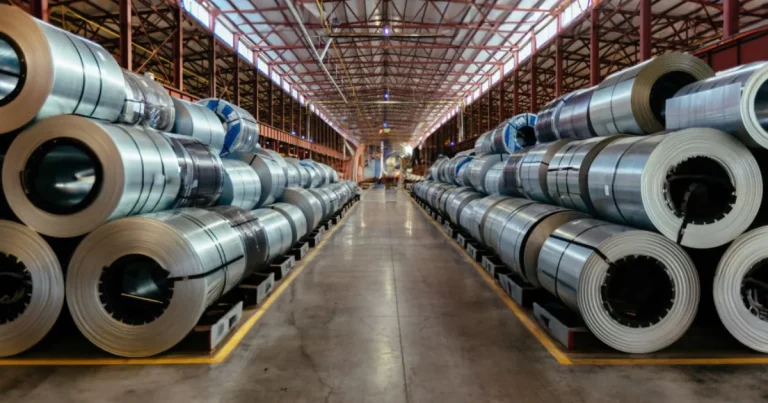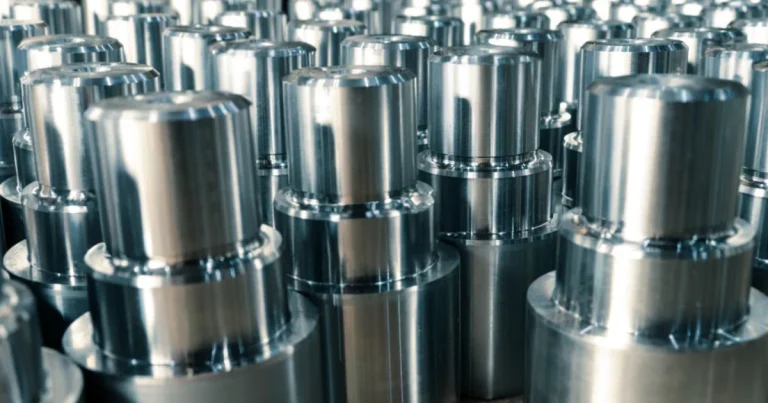Technical Resources
904L (UNS N08904 / 1.4539) super austenitic stainless steel
- Forms : ["seamless_pipe","pipe_fittings","steel_plate"]
904L (UNS N08904 / 1.4539) is a high-performance super austenitic stainless steel with exceptional corrosion resistance properties. This premium grade features high levels of chromium (20%), nickel (25%), molybdenum (4.3%), and copper (1.5%) to provide outstanding resistance to a wide range of corrosive environments, particularly in sulfuric and phosphoric acids.
As a multipurpose austenitic stainless steel with a Pitting Resistance Equivalent Number (PREN) of ≥34, 904L offers superior corrosion resistance compared to standard austenitic grades like 316L. The combined addition of high nickel and molybdenum content provides enhanced resistance to stress corrosion cracking, while its low carbon content (≤0.020%) ensures excellent intergranular corrosion resistance in the welded condition.
904L stainless steel is particularly valued in applications dealing with medium to severe corrosive solutions, where its balanced combination of mechanical properties and corrosion resistance makes it an ideal choice for demanding industrial environments. This versatile grade provides approximately twice the strength of conventional 300-series stainless steels while maintaining excellent ductility and impact strength.
Study on Welding Process of Super Austenitic Stainless Steel 254SMo
- Forms : TGS-61 (type ERNiCrMo-3)
- Grade : 254SMO & S31254
- Study on Welding Process
Super austenitic stainless steel 254SMo is widely used in chloride-rich marine environments due to its excellent pitting corrosion resistance and relatively low cost. This paper mainly discusses the characteristics and welding technology of 254SMo steel. Through welding experiments on 254SMo steel, followed by post-weld mechanical and corrosion performance tests, and qualitative and quantitative analysis of the metallographic structure, the welding process for 254SMo steel was determined. Correct welding techniques and reasonable welding parameters are key to ensuring that the welded joint meets both mechanical and corrosion resistance requirements.
1. Test Method
To verify the applicability of the welding process, one test piece each of two specifications of 254SMo steel pipes, φ60.3mm×5.54mm (Test Pipe 1) and φ168.3mm×11mm (Test Pipe 2), were selected for welding. Post-weld mechanical and corrosion performance tests were conducted. The test process and methods are as follows.
(1) Welding Materials 254SMo steel can be welded using various methods such as Tungsten Inert Gas (TIG) welding, Shielded Metal Arc Welding (SMAW), and Submerged Arc Welding (SAW), but the most commonly used is still TIG welding. Based on the actual engineering requirements, this paper selected TIG welding.
When welding 254SMo steel with welding materials that have matching chemical compositions, two major weaknesses are prone to occur: First, due to the influence of the welding thermal process, severe segregation of alloy elements occurs in the austenitic structure of the fusion zone. Particularly, elements like Cr, Mo, and N, which directly affect the corrosion resistance of the weld joint, tend to segregate towards the grain boundaries, while the alloy content within the grain cores decreases sharply, making these areas weak points against corrosion. Second, because the molten pool solidifies in the austenitic region, both the weld metal and the Heat-Affected Zone (HAZ) have a greater tendency for hot cracking. Based on the above two points, welding materials with chemical compositions matching the base metal are generally not recommended for welding 254SMo steel. Since Mo element can significantly improve corrosion resistance while also reducing the hot cracking tendency, high-Mo Ni-based alloy welding materials are usually selected, among which ERNiCrMo-3 is commonly used.
This paper selected TGS-61 (type ERNiCrMo-3) solid TIG welding wire. The chemical composition of the welding wire is shown in Table 1. The shielding gas for both the front and back sides was Argon gas with a purity ≥99.99%.
Table 1 Chemical Composition of ERNiCrMo-3 Welding Wire

(2) Base Metal The test pipes were 254SMo steel pipes produced by Sweden’s Sandvik company, delivered in the solution-annealed condition. The chemical composition and mechanical properties of the base metal are shown in Tables 2 and 3.
Table 2 Chemical Composition of 254SMo Steel Chemical Composition (Mass Fraction, %) Pitting Resistance
C Si Mn P S Cr Ni Mo Cu N Equivalent (%)
Standard Value 0.020 0.80 1.00 0.030 0.010 19.5~20.5 17.5~18.5 6.0~6.5 0.50~1.00 0.18~0.22 >42
Test Pipe 1 0.008 0.41 0.77 0.019 0.0008 19.85 17.85 6.04 0.51 0.203 43
Test Pipe 2 0.013 0.36 0.66 0.024 0.0004 19.62 18.24 6.10 0.71 0.212 43
Table 3 Mechanical Properties of 254SMo Steel Yield Strength/MPa Tensile Strength Elongation
254SMo
(3) Groove Design The groove form is shown in Figure 1, with a 60° groove angle and a 1~1.5mm root face.
Figure 1 Groove Form
(4) Pre-weld Preparation The groove was obtained by machining. Before welding, the area within 50mm of the groove surface on both the inside and outside of the pipe must be cleaned to ensure the absence of oil, rust, or other contaminants (use acetone to clean oil stains). Like conventional austenitic stainless steel, super austenitic stainless steel does not require preheating before welding.
(5) Welding Parameters To ensure the corrosion resistance of the weld area and prevent hot cracking, heat input and interpass temperature must be strictly controlled during welding. The heat input should be controlled below 2.0 kJ/mm, and the interpass temperature should be controlled below 150°C. The welding parameters are shown in Table 4.
Table 4 Welding Parameters Welding Material Current Arc Voltage Heat Input
Weld No. Pass Designation Diameter/mm Polarity/A Current/V
I Root TGS-61 2 DCEN 95 12 1.1
II Fill/Cap TGS-61 2 DCEN 105 13 1.2~1.4
III Root TGS-61 2 DCEN 105 13 1.2
IV Fill/Cap TGS-61 2 DCEN 115 13 1.2~1.6
2. Test Results
(1) Mechanical Tests The results of the mechanical property tests are shown in Table 5. All mechanical property tests passed, with the weld joint strength and toughness meeting the requirements.
Table 5 Mechanical Test Results of Welded Joints Tensile Test Bend Test
Weld No. Specimen ID Specimen Size/mm
MPa Fracture Location Specimen ID Specimen Size/mm Bend Test Result
I A1 19.0×5.9 678 Base Metal A3 38×6 Pass –
II A2 18.5×5.8 727 Base Metal A4 38×6 Pass –
III B1 18.9×11.6 684 Base Metal B3 10×11 Pass –
IV B2 19.5×11.0 723 Base Metal B4 10×11 Pass –
(2) Metallographic Analysis Micro-metallographic analysis was performed on the above specimens, and the conclusions are shown in Table 6. The microstructures are shown in Figure 2. The results show that the entire weld joint area is basically austenitic structure, maintaining consistency with the base metal microstructure.
Table 6 Micro-metallographic Analysis Results Weld No. Location Microstructure (Austenite) (%)
I Weld Metal HAZ 100
II Base Metal 100
III Weld Metal HAZ 100
IV Base Metal 100
Weld Metal (Approximately 100% Austenite)
2013 Issue 12 Welding & Cutting
, held at a constant temperature of 40°C for 72 hours. After removal, they were cleaned, rinsed, blown dry, and dried, then weighed and observed under microscope and electron microscope. The test results are shown in Table 7.
Table 7 Corrosion Test Results
Max. Pit Depth /μm
Group 1 Thin 46.7551 46.7547 1.25×10⁻⁵ 0.69 0.98
Group 2 Thin 91.6846 91.6834 3.15×10⁻⁵ 0.63 21.67
Group 3 Thin 46.9692 46.9699 5.26×10⁻⁵ 0.44 9.85
Group 4 Thin 96.6399 96.6388 2.65×10⁻⁵ 0.26 0.95
Group 5 Thin 42.235 42.2349 3.21×10⁻⁶ 0.35 5.91
Group 6 Thin 96.6133 96.6132 2.57×10⁻⁶ 0.26 2.95
According to the design requirements, after corrosion testing, the specimen surface should have no visible pits observed by the naked eye, the maximum pit depth should be <0.025mm, and the weight loss should be <0.0001g/cm². By comparing pictures of the specimens before and after corrosion, it can be seen that the specimen surfaces are smooth, with no visible pits observed by the naked eye. Under a continuous zoom stereo microscope (20×), the pits are extremely dispersed, and the measured maximum depths are all <0.025mm, and the weight loss is also <0.0001g/cm². All indicators meet the design requirements. It is concluded that the above weld joints have good pitting corrosion resistance in a 40°C chloride-rich environment.
3. Conclusion
Through multiple welding tests, the welding parameters for 254SMo steel were determined, mastering the welding technology for this type of steel and solving technical problems in production. Using the high-Mo Ni-based ERNiCrMo-3 TIG welding wire as the welding material for S254Mo, while reasonably controlling heat input and interpass temperature (heat input <2.0 kJ/mm, interpass temperature <150°C), and under the premise of strict protection of the welding area with argon gas, the shortcomings of alloy element segregation and welding hot cracking tendency that are prone to occur when using welding materials with matching chemical composition were overcome. Weld joints that meet both mechanical property and corrosion resistance requirements were obtained.
Super austenitic stainless steel 254SMo, with its excellent performance and relatively low cost, will undoubtedly find increasingly widespread application in the offshore oil industry. MW (20130103)
HAZ (Austenite) Base Metal (Austenite)
(a) Weld I (500×)
HAZ (Austenite) Base Metal (Austenite)
(b) Weld II (500×)
Figure 2 Metallographic Structure
(3) Corrosion Test The pitting corrosion test was conducted according to ASTM G48 Method C to measure weight loss, pitting density, and maximum pit depth. Standard specimens of 25mm×50mm were used, with the weld located in the middle of the length direction, obtained by machining, and ground and polished to achieve a uniform surface roughness. They were divided into three groups, with one thick and one thin specimen in each group. The specimens were immersed in a prepared FeCl₃ solution
904L Stainless Steel Strips
- Forms : ["steel_plate","steel_coil"]
The offered UNS N08904 Stainless Steel Strips have good oxidation resistance and structural stability at high elevated temperatures. You can perform all conventional welding methods on these 904L Stainless Steel Strips and they do not require pre-heat or post-heat treatments. We also offered these Stainless Steel 904L Strips in customized form with respect to shapes & sizes.
Moreover, ASTM A276 Stainless Steel 904L Strips are used in oil refinery industries, gas scrubbing plants, paper & pulp industries, chemical & food processing, and shipbuilding, etc. All the products are supplied based on the most reasonable rates in the market with quality service. Please Contact us to know the latest price of these strips and get a FREE estimation.
Stainless Steel 904L Strips in Brazil, Stainless Steel Strips in Singapore, Stainless Steel Strips Price, Stainless Steel Strips Coils, Stainless Steel UNS N08904 Strips for Door, Stainless Steel for Floor, Flat Stainless Steel Strip, Spring Stainless Steel Strip Manufacturer
904L Stainless Steel Strip Specifications:
Grades
Stainless Steel J1, J2, J4, 201, 202, 301, 304, 304H, 304L , 309, 309S, 310, 310S, 316, 316L, 316Ti, 321, 321H, 347, 409, 410, 410S, 420, 430, 441, 904L
Thickness
0.02mm – 5.0mm
Width
3.2mm – 1500mm
Length
AS PER CUSTOMER’S REQUIREMENT
Type of Material
STAINLESS STEEL SOFT, DEEP DRAW, EXTRA DEEP DRAW, QUARTER HARD, HALF HARD,FULL HARD.
Test Certificate
Yes.
Finish
NO.1, 2B, 2D, 2H, 2R, No.4, HAIRLINE, SCOTCH BRITE, SATIN FINISH, NO.8, BA.
Make
JINDAL, BAHRU, POSCO KOREA, POSCO THAINOX, COLUMBUS, ACERINOX, APERAM, TISCO, NISSHIN, NIPPON AND MANY MORE MILLS.
Chemical Composition of Stainless Steel 904L Strip
C
Cr
Cu
Mn
Mo
Ni
P
S
Si
Max
Max
Max
Max
Max
0.02
19.0-23.0
1.0-2.0
2.0
4.0-5.0
23.0-28.0
0.045
0.035
1.0
ASTM A240 SS 904L Strip Mechanical Properties
Grades
SS 904L
Density
8
Melting Point
1300 – 1390 ℃
Tensile Strength
490
Yield Strength (0.2%Offset)
220
Elongation
35% min
Hardness (Brinell)
–
Equivalent Grades of 904L Stainless Steel Strip
STANDARD
WERKSTOFF NR.
UNS
JIS
BS
KS
AFNOR
EN
SS 904L
1.4539
N08904
SUS 890L
904S13
STS 317J5L
Z2 NCDU 25-20
X1NiCrMoCu25-20-5
Dimensions Standard of 904L Stainless Steel Strip :
SS 904L strip Thickness
SS 904L strip Size
SS 904L strip Weight per Unit Area
Estimated Weight per strip
0.015 inches 0.381 mm
36 x 96
0.630 lbs/ft²3.07566 kg/m²
15.12 lbs6.84936 kg
0.015 inches 0.381 mm
36 x 120
0.630 lbs/ft²3.07566 kg/m²
18.90 lbs8.5617 kg
0.0178 inches 0.45212 mm
36 x 96
0.756 lbs/ft²3.690792 kg/m²
18.15 lbs8.22195 kg
0.0178 inches 0.45212 mm
36 x 120
0.756 lbs/ft²3.690792 kg/m²
22.68 lbs10.27404 kg
0.0178 inches 0.45212 mm
48 x 96
0.756 lbs/ft²3.690792 kg/m²
24.19 lbs10.95807 kg
0.0178 inches 0.45212 mm
48 x 120
0.756 lbs/ft²3.690792 kg/m²
30.24 lbs13.69872 kg
0.0235 inches 0.5969 mm
30 x 96
1.008 lbs/ft²4.921056 kg/m²
20.16 lbs9.13248 kg
0.0235 inches 0.5969 mm
30 x 120
1.008 lbs/ft²4.921056 kg/m²
25.20 lbs11.4156 kg
0.0235 inches 0.5969 mm
36 x 96
1.008 lbs/ft²4.921056 kg/m²
24.19 lbs10.95807 kg
0.0235 inches 0.5969 mm
36 x 120
1.008 lbs/ft²4.921056 kg/m²
30.24 lbs13.69872 kg
0.0235 inches 0.5969 mm
36 x 144
1.008 lbs/ft²4.921056 kg/m²
36.29 lbs16.43937 kg
0.0235 inches 0.5969 mm
48 x 96
1.008 lbs/ft²4.921056 kg/m²
32.26 lbs14.61378 kg
0.0235 inches 0.5969 mm
48 x 120
1.008 lbs/ft²4.921056 kg/m²
40.32 lbs18.26496 kg
0.0235 inches 0.5969 mm
48 x 144
1.008 lbs/ft²4.921056 kg/m²
48.39 lbs21.92067 kg
0.0291 inches 0.73914 mm
30 x 96
1.260 lbs/ft²6.15132 kg/m²
25.20 lbs11.4156 kg
0.0291 inches 0.73914 mm
30 x 120
1.260 lbs/ft²6.15132 kg/m²
31.50 lbs14.2695 kg
0.0291 inches 0.73914 mm
36 x 96
1.260 lbs/ft²6.15132 kg/m²
30.24 lbs13.69872 kg
0.0291 inches 0.73914 mm
36 x 120
1.260 lbs/ft²6.15132 kg/m²
37.80 lbs17.1234 kg
0.0291 inches 0.73914 mm
36 x 144
1.260 lbs/ft²6.15132 kg/m²
45.37 lbs20.55261 kg
0.0291 inches 0.73914 mm
48 x 96
1.260 lbs/ft²6.15132 kg/m²
40.32 lbs18.26496 kg
0.0291 inches 0.73914 mm
48 x 120
1.260 lbs/ft²6.15132 kg/m²
50.41 lbs22.83573 kg
0.0291 inches 0.73914 mm
48 x 144
1.260 lbs/ft²6.15132 kg/m²
60.49 lbs27.40197 kg
0.0355 inches 0.9017 mm
30 x 96
1.512 lbs/ft²7.381584 kg/m²
30.24 lbs13.69872 kg
0.0355 inches 0.9017 mm
30 x 120
1.512 lbs/ft²7.381584 kg/m²
37.80 lbs17.1234 kg
0.0355 inches 0.9017 mm
36 x 96
1.512 lbs/ft²7.381584 kg/m²
36.29 lbs16.43937 kg
Width Chart of 904L Stainless Steel Strip :
Nominal gage (mm)
Under 80 mm
Over 80 to 160 mm
Over 160 to 250 mm
Over 250mm
Under 0.16
± 0.10
± 0.10
± 0.10
± 0.15
Over 0.16 to 1.00
± 0.15
± 0.15
± 0.20
± 0.25
Over 1.00 to 1.60
± 0.20
± 0.20
± 0.25
± 0.30
Stainless Steel 904L Strips Updated Price List:
Quality of Microstructure of Duplex Stainless Steels
- Forms : pipe, plate, sheet, tube and bar
- Grade : Duplex stainless steels 2205
- The metallurgy of duplex stainless steel
The metallurgy of duplex stainless steel is very interesting indeed. It is made from two different grades of metal (ferritic and austenitic), and it therefore benefits from the properties of both microstructures.
The metallurgy of duplex stainless steel can be characterised by the fact that it is a Fe-Ni-Cr alloy, and it has a two-phase ferritic-austenitic stainless-steel microstructure when it is at room temperature.
Duplex stainless steels are characterised by high chromium (19–28%) and molybdenum (up to 5%) and lower nickel contents than austenitic stainless steels. The most used duplex stainless steels are the 2205 (22% Chromium, 5% Nickel) and the 2507 (25% Chromium, 7% Nickel); 2507 is known as “super duplex” due to its higher resistance to corrosion.
Duplex stainless steel is highly sought after in heavy industries, like oil and gas nuclear and chemical processing.

The metallurgy of duplex stainless steel
The origin of duplex steels can be traced back to the 1920s, with the first cast being made in Sweden in 1930. The popularity of duplex started to rise in the 1990s when steelmaking technology became more advanced.
The production of a metal with a ferritic-austenitic microstructure was ground-breaking as it meant that it had higher strength, good weldability, good toughness and resistance to stress corrosion cracking.
Compared with austenitic grades, duplex steels characteristically have high chromium content but a rather low nickel content. Molybdenum and nitrogen are added to the metal in order to improve corrosion resistance and balance the microstructure. Nitrogen also increases the mechanical strength.
Varieties of Duplex Stainless Steel
Duplex stainless steels are typically divided into three groups based on their pitting corrosion resistance. The three groups are:
– Standard duplex (PREN range: 28–38, Grade 2205): Standard Duplex Stainless Steel is typical of the mid-range of properties and is perhaps the most widely used today.
– Super-duplex (PREN range: 38-45): Super Duplex metal was developed later than standard duplex steel to meet the specific demands of the oil and gas industry, as well as those of the chemical industries. It has a superior resistance to corrosion and a higher strength, but it is more difficult to process because of the higher contents of Chromium, Molybdenum, Nitrogen and Tungsten. Applications of super duplex include deep-water offshore oil production.
– Lean duplex grades (PREN range: 22–27): Lean duplex steel is the most recently developed of the three grades and it is particularly used in the building and construction industry. It has higher mechanical properties meaning that it is often used in applications where strength is important such as in bridges, pressure vessels or tie bars.
Properties of Duplex Stainless Steel
Duplex stainless steel has a variety of useful properties including:
– Strength:Duplex stainless steels have approximately double the strength of regular austenitic or ferritic stainless steels.
– Toughness and ductility:Duplex stainless steels exceed the toughness and ductility of ferritic grades although they are not as tough as austenitic grades.
– Corrosion resistance:As with all stainless steels, corrosion resistance depends mostly on the composition of the stainless steel, with chromium, molybdenum and nitrogen content being the most important. Duplex stainless steels are extremely corrosion resistant and even in chloride and sulphide environments, duplex stainless steels exhibit very high resistance to stress corrosion cracking (SCC). SCC is a type of corrosion that takes place when a particular set of factors are present: Tensile stress, corrosive environment and a sufficiently high temperature.
– Heat Resistance: Duplex stainless steel has higher heat conductivity and lower thermal expansion than austenitic steels. Duplex grades can easily be used at low temperatures such as -50°C because at low temperatures they have better ductility that ferritic grades of steel.
– Cost:Duplex stainless steels have lower nickel and molybdenum contents than their austenitic counterparts. This lower alloying content means that duplex stainless steels can be lower in cost. Further to this, it is also possible that the thickness of duplex stainless steel can be reduced as it has an increased yield strength. Thinner products mean that significant weight savings can be made.
– Weldability: Duplex stainless steels tend to have good weldability and all standard welding processes can be used although they are not quite as easily welded as the austenitic grades.
This array of properties means that duplex stainless steel can be found in many different applications such as:
– Chemical processing, transport and storage
– Pipes for production and transportation of oil and gas
– Oil and gas exploration and offshore rigs
– Oil and gas refining
– Marine environments
– Pollution control equipment
– Pulp & paper manufacturing
– Chemical process plants
– Structural and mechanical components
– Heat exchangers
– Cooling pipes
Weldability of Duplex Stainless Steel
Welding duplex stainless steel is not particularly difficult but it has to be approached differently to other steels. It is generally thought that the weldability and welding characteristics of duplex stainless steels are better than those of ferritic steels, although maybe not as good as austenitic steels. Interestingly, modern duplex steels with improved nitrogen content are readily weldable.
It is important to note that the properties of duplex steel can be affected by welding parameters such as heat input. This is because the duplex microstructure is more sensitive compared to standard austenitic grades.
Rapid cooling from the high temperatures used during the welding process result in high ferrite levels in the weld metal and adjacent base metal. To combat this, filler metals are used which have been specially designed with higher nickel contents to produce a phase balance like that of the base material.
Consequently, this means that welders should be sure to carry out correct welding procedures to obtain the acceptable weldment structure and properties.
Why Alloy 718 is the Go-To Material in Aerospace Applications
Despite the development of newer nickel alloys like Waspaloy, Rene 41, and Alloy 625, Alloy 718 remains the benchmark for a simple reason: It offers the best cost-to-performance ratio across a wide range of operating conditions.
Advantages over other aerospace superalloys:
Easier to weld and fabricate
Lower material and processing costs
Good availability in bar, plate, sheet, and forgings
Established pedigree with extensive aerospace approvals (AMS, ASTM, and ISO standards)
Because of this, Alloy 718 is not only specified in legacy platforms but continues to be incorporated into next-generation engines and launch systems.
Things to Know About PREN
Corrosion Resistance: The composition of duplex stainless steels sets it apart from regular austenitic and ferritic grades in terms of corrosion resistance to aqueous chloride solutions. The pitting resistance equivalent number (PREn) is a calculated value that utilizes specific elements in a grade’s chemistry to roughly rank grades with respect to their pitting corrosion resistance when exposed to aqueous chloride-containing solutions. Duplex stainless steels are often lean in more expensive alloying elements such as nickel, which are substituted with alloying elements such as nitrogen, molybdenum, chromium, and tungsten, which greatly enhances the PREn. The formula for PREn is %Cr + 3.3 x %Mo + 16 x %N. For more in-depth information on the PREn, see our blog, Things to Know About PREn. Additionally, duplex stainless steels are less prone to chloride stress corrosion cracking (CSCC) than austenitic stainless steels like 304/304L and 316/316L due to their dual-phase microstructure. For information on stress corrosion cracking, see our blog, Stress Corrosion Cracking.
Ease of Fabrication: Due to their higher ductility, duplex stainless steels are often more formable than ferritic grades. The higher ductility of duplex stainless steels is attributed to them containing approximately 50% austenite. Duplex stainless steels are also highly weldable in thick and thin sections. To better understand the best practices when welding duplex stainless steel, see our webinar, Best Practices When Using Duplex Stainless Steel.
QUOTE, BUY, TRACK
We make it easy to get instant pricing and purchase your metal at the click of a button. Track your order progress, get notified when it ships, and follow your shipment online until it’s delivered. It’s that easy!






